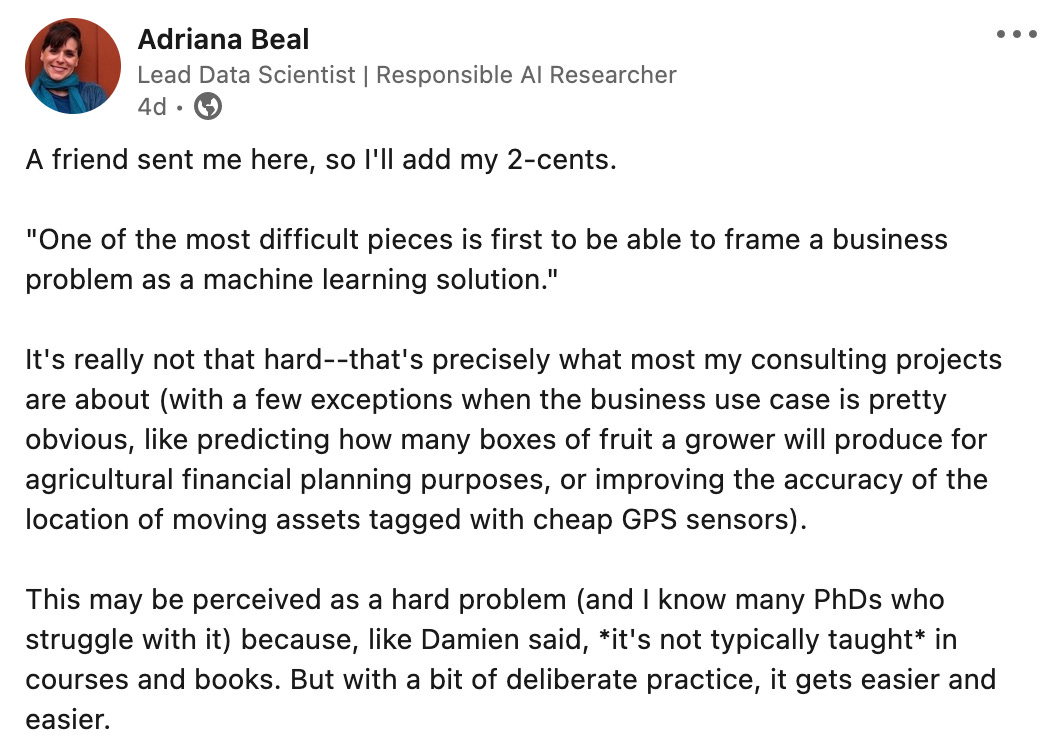Framing a machine learning challenge as a business problem
It's only hard if you use the wrong mental model
Someone recently directed me to a post in LinkedIn where the author said,
The hardest thing about Machine Learning is NOT about training models or the math behind the algorithms! In fact, that might the easiest thing and interestingly enough, that is the only thing that is taught in school or in textbooks.
One of the most difficult pieces is first to be able to frame a business problem as a machine learning solution. (…)
I didn’t ask, but it’s possible that the person who brought the post to my attention expected me to agree with this statement. This is because framing the business problem is a big part of my job, and it would be nice to be able to advertise it as being a very difficult task :-).
But in reality, I had a different take:
Take a look at these descriptions of machine learning problems one can find in data science books and online challenges:
Extract skill requirements from job posting data.
Predict future friendships from social network data.
Compute travel probabilities using graph theory techniques.
Track disease outbreaks using a cluster algorithm.
Assess online ad clicks for significance.
These, of course, are not good descriptions of business problems. These are challenges that have been conveniently framed to reflect what machine learning does best: find underlying patterns that may be difficult to identify by inspecting the data manually.
And because this is how machine learning challenges are typically presented to students and PhD candidates, many find it difficult to reframe their problems in business terms.
But this is a barrier that a bit of deliberate practice can solve. What is missing here is a link between the machine learning challenge you’re describing and a business solution that can produce a concrete business gain, such as maximize revenue yield or reduce the time to decide and the cost of decisions.
Finding the business purpose for a predictive model
With any predictive model, the business purpose needs to come first, explaining not only what you hope to predict, but also why.
Assess online ad clicks for significance is a bad description for a machine learning project because it doesn’t explain why.
Imagine that you’re working for a retailer using online ads to attract customers. The businesss is interested in increasing revenue and profitability. An executive heards that machine learning models are helping competitors achieve this goal, and hires a data scientist to start building some models.
Someone — either the data scientist or a savvy business analyst — has to make a connection between the large picture (increase revenue and profitability) and the contributions to operational decisions that a machine learning solution can provide.
During this process, a series of use cases may be identified:
Determine the cross-sell offer with the highest likelihood to convert so that the best offer can be displayed to each customer during checkout.
Identify customers who are ready to make a purchase in a specific product category within the next few days so that the marketing department can react accordingly (send them an email offer, display the appropriate ad).
Distinguish customers who will only make a purchase if given a discount vs. others who will buy at full price so that only the former are given a discount to protect profitability.
Calculate the likelihood of a paid ad improving the loyalty of an existing customer, measured by their willingness to buy other, more profitable, products so that the company only pays for ads that help the bottom line.
This list could go on and on, all focused on models to support high-volume operational decisions that help increase conversion, loyalty, or profitability.
As part of a ranking process, the team would be looking at the benefits of each solution in terms of speed, efficiency gains, cost redutions, adaptability, learning-improvement loops, as well as the costs to build and maintain the required technologies.
It is possible this analysis will show that machine learning can help increase the precision, consistency, and agility of all these operational decisions while reducing the time to decide and the cost of the decision.
If so, the next step would be to try to quantify the return expected from each model. For example, an accurate model to predict which cross-sell offer will convert more at checkout time may have the potential to generate $2M a month, while a near-perfect classification of customers who need a discount to buy may only have the ability to bring in $500K a month.
Assuming the same effort to build both models, the cross-sell model could then be prioritized ahead of the “customers who need a discount to buy” model.
Formulating your problem as a machine learning problem
Most real-world machine learning problems are about finding patterns in data. But such problems are only worth solving if they can produce a concrete business gain. In practicae that typically means building a model that generates an output that automates, expedites, or improves an operational decision.
If you are given a machine learning challenge to work on, try adding the “so that…” part to your ML problem. If you can’t answer how your solution will increase the precision, consistency, or agility of a business decision, and/or reduce the time to decide and the cost of the decision, you probably don’t have a well-formulated business problem yet.



